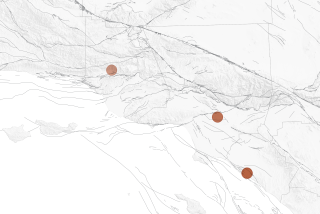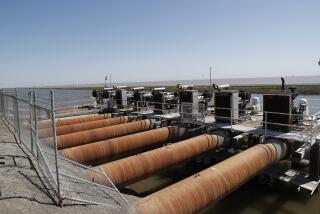Subduction Zones Shift to Forefront in Earth Studies : Science: Researchers say the areas where ‘slabs’ of one tectonic plate dive under another have caused major quakes and played a role in volcanoes.
- Share via
When a magnitude 9.5 earthquake struck off the Chilean coast in 1960, and a magnitude 9.2 occurred off Alaska in 1964, scientists were at first not even aware that subduction zones were involved.
By the time three quakes reaching a top magnitude of 7.1 took place off the Humboldt County coast in 1992, it had been established that the nearby Cascadia subduction zone, stretching in the ocean from Vancouver Island south to Cape Mendocino, threatened a great damaging quake in the U.S. Northwest. Further, it was known that the zone was linked to the explosive volcanoes of the Cascade Range.
In the last two years, subduction zones--where 50-mile thick “slabs” of one great tectonic plate dive under another--have assumed an importance in earth sciences far beyond what researchers thought before.
At a recent conference on Santa Catalina Island that for the first time brought together scientists from various disciplines who have been studying the subduction process, the key speaker, Seiya Uyeda of Japan, portrayed subduction zones as the star player of world geology.
“It is now possible to say that subduction . . . plays a more fundamental role than sea-floor spreading in shaping the Earth’s surface features, running the plate tectonic machinery and even in controlling the evolutionary process of the entire Earth,” Uyeda said.
Beyond causing some of the greatest earthquakes known, and playing a role in some of the most devastating volcanic eruptions, subduction is responsible for a massive recycling of water, chemicals and gases from the crust down into the mantle and then back up again, scientists now believe.
Environmentally sensitive gases such as carbon dioxide and methane, for instance, are believed to be carried downward by the cooler, more dense subducting slabs into the mantle, only to re-emerge much later--the process happens over a period of tens of millions of years--from volcanoes or by expulsion in frozen form into the deepest ocean trenches.
“The basic question here is how to explain these phenomena,” Uyeda said.
Explanations are proceeding, but also at a slow pace. In a break from conventional theory, Seth Stein of Northwestern University asserted that it is the sliding of the Pacific plate under the tectonic plates in Alaska and the North Pacific that “is pulling parts of California north” through the medium of great quakes along the San Andreas Fault.
That means that it is not so much forces within California that generate the seismic activity in the state, he suggested, as it is the subduction processes occurring 1,500 and more miles away.
Robert I. Tilling of the U.S. Geological Survey said that more than 260,000 people have died since the year 1600 as a result of volcanic eruptions, most of which were the product of subduction.
With subduction as the keystone, scientists drew an emerging scenario of earthquakes and volcanoes:
* The diving slabs are considerably colder, on the order of hundreds of degrees, than the surrounding hot subterranean rocks through which they are descending. The slow sinking process is believed to be generated by the higher density of the colder slabs.
* The top surface of the slabs carries water both in sediments and in the rock below. Over millions of years, as the slab descends into the Earth’s mantle, these waters are released and percolate upward, causing melting of hot rocks in what is known as the “mantle wedge” between the two interacting tectonic plates.
* These melted rocks eventually rise to the surface as magma, or lava, that is erupted by volcanoes.
* Deep earthquakes, such as the magnitude 8.2 temblor that struck 400 miles underneath Bolivia on June 8, are the product of the squeezing of slabs that have descended very deep into the mantle.
The details of processes in which minerals and gases are recycled, often emerging in sea bottoms, is less well-known, but the general concept is valid, said David W. Scholl of the Geological Survey.
“These elements are brought down into the Earth, heated up and squished back out into the atmosphere,” Scholl said. “Hydrocarbons are heated up and squished back out. Frozen methane is expelled right into the sea bottoms.”
This is a picture of a dynamic Earth, driven by the silent, somber forces of subduction.
Subduction, said geologist William M. White of Cornell University, is one of the key processes mixing the Earth chemically. The Hawaiian Islands, which lie over “hot spots” in the mantle, are one area where material carried downward by the slabs is re-emerging, he said.
Steve Kirby, another Geological Survey scientist, noted that in the world’s many subduction zones, there is “a close relationship between where earthquakes are, where volcanoes are and the location of anomalies of the Earth’s crust.”
The relationship is evident in the Cascadia subduction zone, a boundary where three tectonic plates--the Pacific, the Gorda and the North American--come together. Very large earthquakes apparently occur every few hundred years 50 to 100 miles off the coast, generating dangerous tsunamis. One hundred miles inland, where the slab has burrowed deeper under the surface, are the Cascade volcanoes.
Vessels of the National Oceanic and Atmospherics Administration have also been exploring undersea volcanic eruptions several hundred miles off the Oregon coast in a possible area of other subducting slabs.
Scientists at the meeting concluded that while they have a handle on the broad picture of subduction, many details--such as the gradual heating of the slabs, or the existence of double seismic zones on each side of some slabs--remain a mystery.
Underground Movement
Scientists believe that subduction zones, where 50-mile-thick slabs of one tectonic plate drive under another, are responsible for a variety of earthquakes, volcanic eruptions and a massive recycling of water, chemicals and gases. Here is a look at how the zones work, as seen off the northwest U.S. coast.
1) Over tens of millions of years, a leading slab of one tectonic plate dives under another, carrying with it sediments filled with water and minerals.
2) Cool subductive slab is gradually squeezed and heated, resulting in earthquakes.
3) When the slab dehydrates, water is released into hot rocks in the mantle, melting them.
4) Magma is sent upward to be erupted by volcanoes.
More to Read
Sign up for Essential California
The most important California stories and recommendations in your inbox every morning.
You may occasionally receive promotional content from the Los Angeles Times.













